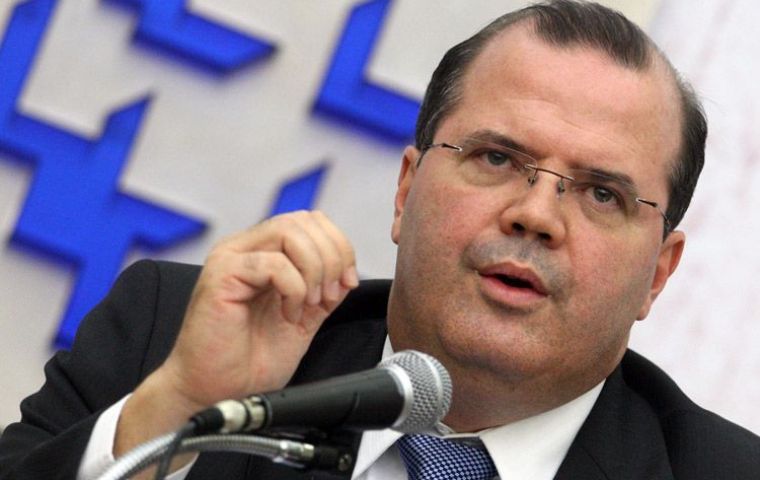MercoPress. South Atlantic News Agency
Brazil cuts benchmark rate for ninth time running to an all time low of 7.5%
 Tombini started the path to lower rates a year ago when the Selic was at 12.5%
Tombini started the path to lower rates a year ago when the Selic was at 12.5% Brazil’s central bank cut the benchmark interest rate for the ninth straight time on Wednesday to an all-time low of 7.5%, as policymakers keep up efforts to bolster a slow-moving economy which is the world's sixth-largest.
Those efforts seem to be paying off as retail sales and economic activity data jumped unexpectedly in June, raising hopes for a stronger recovery following a flurry of government stimulus measures like tax with a last chapter on Wednesday.
A pick-up in activity has also raised fears of inflation becoming a problem next year after a recent jump in global food prices reversed the downward trend of 12-month inflation.
Higher annual inflation, which at 5.37% is above the 4.5% midpoint of the official target range, could put pressure on the central bank's monetary policy committee, known as Copom, to end the rate-cutting cycle as early as October.
“Given the large monetary stimulus already introduced, and rising inflation risk, there is a chance the central bank could signal that the easing cycle is near its end,” Jose Carlos de Faria, analyst with Deutsche Bank, said in a note.
Most economists expect the bank to slash rates by 25 basis points in October before ending the cycle that has brought Brazilian rates, among the world's highest, closer to those of other emerging-market giants such as India and Russia.
Economists widely expect the Selic rate to remain in single digits for the foreseeable future, no small feat in a country with a long history of runaway inflation and where interest rates hit nearly 30 percent less than a decade ago.
Lower rates are a top priority for President Dilma Rousseff, who has not bowed to pressure from thousands of striking public servants to increase spending, which could stoke inflation and force the central bank to raise rates in the near future.
The path to lower rates began a year ago when policymakers, led by Central Bank President Alexandre Tombini, abruptly reversed course and started cutting the Selic, which stood at 12.5%.
Since then Tombini has not stopped, trimming 450 basis points off the Selic in a bid to shield the economy from a worsening European debt crisis as local inflation eased.
Rousseff has aided his efforts by slashing taxes on everything from cars to home appliances and keeping public spending in check. The government has also instructed state banks to increase lending to businesses at lower interest rates.
But anaemic investment, high production costs and lack of skilled labour are blamed for the slow growth in Brazil as consumers start to reach their debt limits after a credit boom.
The brief release from the central bank after a twi-day meeting said that Copom decided, unanimously, to reduce the Selic rate to 7.5% p.a., without a bias.
“Considering the cumulative and delayed effect of policy action implemented until now, which are partially reflected in the ongoing economic recovery, the Copom considers that if the prospective scenario were to allow for an additional adjustment in the monetary conditions, this move should be carried out with maximum parsimony.
“Voting in favour of the reduction in the Selic rate to 7.5% are the following board members: President Alexandre Antonio Tombini, Aldo Luiz Mendes, Altamir Lopes, Anthero de Moraes Meirelles, Carlos Hamilton Vasconcelos Araujo, Luiz Awazu Pereira da Silva, Luiz Edson Feltrim and Sidnei Correa Marques.”




Top Comments
Disclaimer & comment rulesCommenting for this story is now closed.
If you have a Facebook account, become a fan and comment on our Facebook Page!